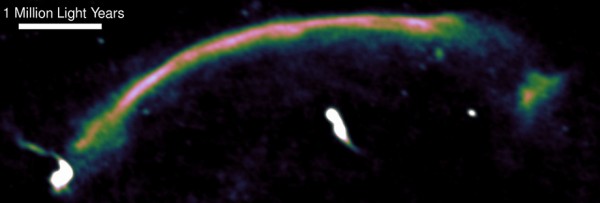Here's How Cosmic Tsunamis Resurrect Dead Galaxies
| Ana Verayo | | Apr 27, 2015 09:08 AM EDT |
(Photo : Andra Stroe/RAS) A radio image highlighting the shock wave (the bright arc running from bottom left to top right) in the ‘Sausage’ merging cluster made using the Giant Metrewave Radio Telescope.
Galaxies are often observed in clusters that contain "red and dead" galaxies that can no longer form new stars. New research, however, reveals enormous "cosmic tsunamis" can resurrect these dead galaxies back to life.
An international team of astronomers compared these galaxies to cities. Not only stars but thousands of galaxies can be gathered in close proximity. In the course of billions of years, these clusters can merge with others, a growth similar to cities that absorb nearby towns as they expand.
Like Us on Facebook
When these clusters collide, a massive shock wave of energy is released can trigger the birth of a brand new generation of stars causing these dormant galaxies to explode into new life.
This study marks the first time evidence was found among the galaxies of this cosmic tsunami effect.
This evidence was observed during a merging galaxy cluster called CIZA J2242.8+5301, also dubbed as "Sausage", located 2.3 billion light years away, said astronomers Andra Stroe and David Sobral from the Leiden Observatory, Netherlands and the University of Lisbon, Portugal.
With the aid of telescopes Isaac Newton and William Herschel on La Palma, Spain along with the Subaru, CFHT (Canada France Hawaii Telescope) and the Keck telescopes in Hawaii, researchers found this particular cluster of galaxies transformed by a shock wave that triggered a new wave of star formation.
It was first assumed galaxies wouldn't be affected by this shock wave but apparently these galaxies have a lead role in this phenomenon since the comatose galaxies in the Sausage cluster are now coming back to life and stars are being churned out at an unprecedented rate.
This shock wave is travelling at an incredible nine million kilometers per hour. It occurred one billion years ago following the collision of the two original clusters. Due to their enormous distances, scientists are just starting to observe this event.
Scientists found out this huge shock wave works by causing turbulence in the galactic gas, triggering a collapse that later led to the formation of super dense, cold gas clouds. This creates a nursery for the formation of new stars that can bring these galaxies back to life.
Sobral said since this shock wave can produce infant stars at a very fast rate, they will become short lived and will explode as supernovae after just a few million years.
These explosions will emit massive amounts of gas that will be hurled away from the galaxies that they will soon run out of fuel. The clusters will become comatose once again and a second resurrection is no longer possible.
This study is in the journal Monthly Notices of the Royal Astronomical Society.
TagsHow Cosmic Tsunamis Can Resurrect Dead Galaxies, cosmic tsunamis, dead galaxies, cosmic tsunamis dead galaxies
©2015 Chinatopix All rights reserved. Do not reproduce without permission
EDITOR'S PICKS
-

Did the Trump administration just announce plans for a trade war with ‘hostile’ China and Russia?
-

US Senate passes Taiwan travel bill slammed by China
-

As Yan Sihong’s family grieves, here are other Chinese students who went missing abroad. Some have never been found
-

Beijing blasts Western critics who ‘smear China’ with the term sharp power
-

China Envoy Seeks to Defuse Tensions With U.S. as a Trade War Brews
-

Singapore's Deputy PM Provides Bitcoin Vote of Confidence Amid China's Blanket Bans
-

China warns investors over risks in overseas virtual currency trading
-

Chinese government most trustworthy: survey
-

Kashima Antlers On Course For Back-To-Back Titles
MOST POPULAR
LATEST NEWS
Zhou Yongkang: China's Former Security Chief Sentenced to Life in Prison

China's former Chief of the Ministry of Public Security, Zhou Yongkang, has been given a life sentence after he was found guilty of abusing his office, bribery and deliberately ... Full Article
TRENDING STORY

China Pork Prices Expected to Stabilize As The Supplies Recover

Elephone P9000 Smartphone is now on Sale on Amazon India

There's a Big Chance Cliffhangers Won't Still Be Resolved When Grey's Anatomy Season 13 Returns

Supreme Court Ruled on Samsung vs Apple Dispute for Patent Infringement

Microsoft Surface Pro 5 Rumors and Release Date: What is the Latest?










